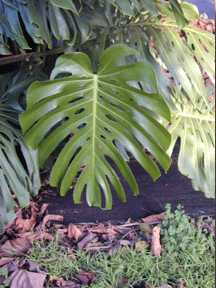Skip to content
Monstera spp.
 PLANT NAME: Monstera spp.
PLANT NAME: Monstera spp.
SIMILARLY USED SPECIES: M. adansonii (syn. M. pertusa); M. deliciosa (syn. Philodendron pertusum); M. dilacerata; M. epipremnoides.(syns M. schleichtleinii, M leichtleinii ); M. friedrichsthalii; M. irritans; M. pertusa
COMMON NAMES: Swiss Cheese Plant, Fruit Salad Plant, Ceriman, Windowleaf [English]; Siparuna [Panama]; Pasmo, Piñanona [Spanish]
FAMILY: Araceae (Taro family)
PROPERTIES: Bland, astringent, neutral.
STATUS IN HAWAI’I: Alien. Minimal pest factor
WESTERN FUNCTIONS: Anti-inflammatory [China], fibrinolytic [China]
TRADITIONAL CHINESE ENERGETIC FUNCTIONS (~ = extrapolated):
 MEDICINAL USES:
MEDICINAL USES:
Infection, Fever [China], Snake bite [Antilles (topical and as a charm)], To cauterize wounds and for leg pain [Bolivia (heated leaves poulticed)]; trauma, bruises [China (poulticed and internal), Cough [China].
USE AS FOOD: Monstera has been grown commercially in Florida. Made into drinks and ices, and put in fruit salads. In Europe Monstera has been used to flavor champagne.
PLANT PART USED: Whole plant. Fruit as food.
CONSTITUENTS: Calcium oxalate, acrid and caustic raphides
CAUTIONS AND CONTRAINDICATIONS: Calcium oxalate crystals! Acrid and caustic raphides! Eat only when ripe. (If you take a bite out of the unripe fruit you’ll regret it)
All species contain a caustic sap which causes blistering. Can cause hives.
PREPARATION OF MEDICINE: Boil well!
NOTES ‘N QUOTES: There are 50 different species of Monstera.

 PLANT NAME: Monstera spp.
PLANT NAME: Monstera spp. MEDICINAL USES:
MEDICINAL USES: